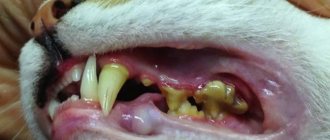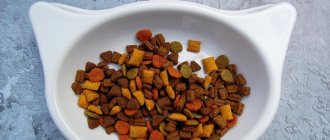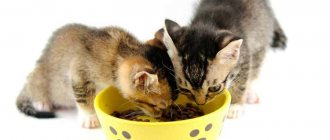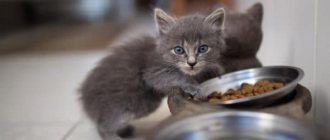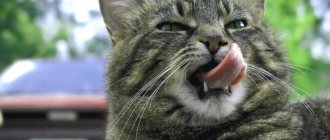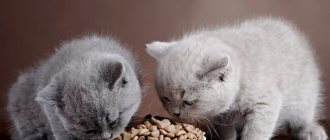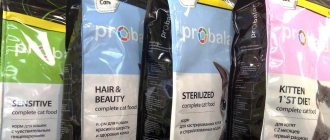Some animal food production standards are said to be superior to human food production standards. They are sourced from the same farms that produced the meat and vegetables you eat. In the article you will learn about the composition and production of dry and wet cat food, why they attract people, whether it is safe for humans to consume cat food and what the possible consequences are.
What is cat food?
Dry cat food
Dry pet food typically consists of meat, bones, muscle and other by-products from meat, poultry and seafood, as well as grains, grains, vegetables, vitamins and minerals.
Dry cat food is dried granules in the form of rings, pads, balls, etc.
Animal parts used for pet food may include damaged parts of the carcass, cheek meat, bones, kidneys, liver, intestines, spleen, lungs, udder and stomach tissue. The cereals used are corn, wheat, and barley. Most manufacturers additionally add proteins, vitamins and minerals to the feed, since they are destroyed when heated. Dry food has a shelf life of 10 to 12 months and requires the addition of preservatives. Some manufacturers use natural preservatives - vitamins E and C.
The production of granulated dry food began in the 80s of the 20th century.
Sometimes manufacturers, in order to reduce the cost of the product, prepare food from grain products with the addition of hydrolysates, thus improving the taste. But the nutritional value of such a product is negligible and disrupts the cat’s metabolism. Choose high-quality, balanced food for your pet!
To produce dry food, the ingredients are selected according to the recipe and carefully ground. The dry ones are mixed with the wet ingredients, water and steam, forming something like a dough. The dough enters the extruder, where it is prepared under pressure and goes out onto a belt, where it is cut into specific pieces. The feed is then oven dried and cooled. At the end of the process, the food pellets are treated with flavorings and preservatives and transferred to the packaging machine.
Dry food contains attractants that cause increased appetite in cats. This is the reason why animals become accustomed to this type of food.
Wet cat food
To prepare liquid food, the same ingredients are used as for dry food, as well as water, blood, and meat broth. Gelling and gelling agents provide humidity, it should be 70-80%. Agents include guar and bean gums, cellulose, starches and thickeners.
Wet food is no better or worse than dry food. Their composition is almost the same, differing only in liquid content.
The ingredients required for the recipe are mixed and ground, then formed into sausages and, after steaming, cut into portions. Next, the pieces with the gelling sauce are packaged in bags. After packaging, the packaging is sterilized and heated to high temperatures to destroy all living organisms that may be present in the mixture (bacteria, mold, viruses). In this form, the food can be stored for two to three years.
Looks really delicious
Preservatives, flavors, vitamins and minerals
Dry food may well contain flavoring additives, because the food should not only be healthy, but also appeal to cats. Modern foods often contain various hydrolysates obtained from natural products, such as liver; they are completely safe for cats and give the food an attractive aroma.
In order for dry food to be stored for a long time, preservatives are added to it, and high-quality dry food uses natural antioxidant complexes based on rosemary, which are absolutely safe for animals. But it is better to avoid synthesized chemical compounds, because the individual reaction to them is quite unpredictable.
Since dry food is produced using high temperatures, some of the beneficial substances from the raw materials are inevitably destroyed, so vitamin and mineral complexes are added to the diet. It is important that the product packaging contains a complete list of substances with dosage information.
Why cat food attracts people
Cat food attracts people, first of all, with attractive marketing names. For example, “Tidbits with duck, rabbit and game”, “Appetizing platter with beef and lamb”, “Pads with tender pate”. Also, thanks to flavorings and taste enhancers, cat food has a rather pleasant smell for humans, which creates the illusion that the taste will be just as pleasant.
A human taste panel study found that people rate cat food between 5 and 9 on a scale of 1 to 10.
There is no dry food that suits everyone
Each animal is individual, and it may well happen that a particular dry food was not suitable for your pet, for example, it caused an allergy or food intolerance. This is not a reason to blame all dry food in general, but it is better to understand the problem and choose a different diet. After all, it is not dry food itself that causes an inadequate reaction of the immune system, but some specific ingredient in it, and consuming it raw, boiled or as part of canned food will lead to the same result.
In addition, not all allergic reactions are caused by food; for example, 80% of cases of itching in cats are caused by banal flea dermatitis. At the same time, it cannot be denied that the animal’s health largely depends on proper nutrition, but most diseases are caused by an unbalanced diet and feeding unsuitable food for cats, so high-quality dry food is just the product that will help keep your pet vigorous and active for many years.
What happens if you eat cat food?
If you try cat food just once, out of curiosity, so to speak, it won't cause any problems. All you have to do is check the “tried” box on your life to-do list.
Is it harmful to eat cat food often? Can a person always eat cat food?
Constant consumption of cat food can cause health problems even in dogs. Since a cat is a carnivore, its diet should contain a high percentage of protein, as well as taurine, vitamin A and fat.
Why can it harm a person? What happens if you consume cat food?
Vitamin A helps maintain eye and heart health in cats. It is extremely important, especially during the growth period of the kitten. The human body does not need large amounts of this vitamin, especially since vitamin A has a cumulative effect. High levels of the vitamin are toxic to humans and can cause cancer, especially in smokers.
Vitamin A hypervitaminosis can lead to baldness, joint pain, bone damage
Taurine is a vital amino acid that prevents tooth decay and hair loss in cats. Since taurine is not produced in the animal’s body on its own, it must be contained in sufficient quantities in food. In humans, the amino acid is synthesized in the required quantity; excess can lead to side effects.
Excess taurine leads to headaches, nausea, dizziness
The main source of energy for cats is fat. Fatty acids are completely absorbed by the animal's body. For humans, excess fat is harmful and can lead to obesity, problems with the heart and blood vessels, liver and gallbladder diseases. Human metabolism is not sufficient to digest the volume of fatty acids that cat food contains.
What you should never give
Of course, the diet can be designed so that it is varied and meets the needs of your furry pet. However, remember that diversification does not mean giving everything that comes to hand. Among the foods that are regularly present in the human diet, there are many that a cat may be interested in, but which cannot be given to it under any circumstances. This includes everything thick, spicy, salted, pickled and smoked. All these products, although they attract cats with their aroma, can lead to metabolic disorders and diseases of the digestive system. Many cats find confectionery products extremely attractive - tea often contains cream or milk cream. But treating pets with cakes, sweets and even condensed milk is strictly prohibited! Chocolate contains substances that are toxic to cats; in addition, carbohydrates are generally very poorly broken down by the digestive system of predators - cats simply do not have specialized enzymes for this.
What happens if a child eats food from a cat bowl?
There is no need to panic and call an ambulance if the child has tried and successfully chewed the food. Cat food is not so harmful that it can cause all diseases at once. But there is a nuance. If the pet lives and lives only at home, does not go outside and is kept clean, in principle there should be no problems. It’s another matter if a child eats from the bowl of a cat who goes outside. The food may contain cat saliva and hair. In addition to food, cat parasites, helminths, and roundworms can also enter the child’s intestinal tract.
What to do in this case? Testing for parasitic infections should be performed. However, if the test is done on the same day or in the near future, it may turn out to be negative, since the parasites have not yet reached their goal and have not had time to reproduce in the body. Therefore, the analysis should be done two weeks after the child has tried cat food.
Parasitic worms cause various diseases
In the future, keep an eye on your baby and do not allow him to eat from the cat's bowl. In addition to parasite infestation, there is a more serious problem - the danger of suffocation. Just like coins, candy, small toys, and magnets, cat food pads should be kept out of the reach of children. Once in the esophagus, food can block the access of oxygen to the lungs. In this case, emergency assistance will be needed. After watching the video, you will learn what to do if a foreign object is stuck in a child’s throat.
How to wean
If a dog constantly steals food from a cat, it is necessary to wean it off. This not only spoils the health of the animal, but can also provoke a serious confrontation between pets. In this war, a third party - a person, as well as his property and nervous system - will suffer.
To wean your dog off cat food, you should follow these recommendations:
- Animals should be fed separately from each other, if possible, placing bowls in different rooms;
- you can try moving the cat's feeding area to a high place where the dog cannot get food from the bowl;
- if an animal really loves cat food and considers it a treat, then you should not give it as a reward during training; it is better to find another method of praise;
- if the dog is so accustomed to cat food that it refuses its own, then you can follow the principle and strictly limit access to the forbidden treat (nothing terrible will happen during a two-day hunger strike, but a psychological victory will be ensured).
You can also try to trick the dog. If he eats cat food for reasons of establishing leadership, thus showing aggression, then you can simply pour dog food into the cat’s bowl.
The owner’s task is to provide the pet’s body with all the necessary substances so that it is healthy and happy. Therefore, you should be very careful when feeding the animal and do not allow it to consume food that is not intended for it.
Benefits and harms for the animal
The benefit is that the cat receives a balanced diet, which does not cost its owners too much. For example, in animal shelters, inexpensive commercial food is a lifesaver for many homeless cats. The main disadvantage of economy class feed is the not very good quality of the raw materials and many artificial additives. You can find a large number of negative reviews from owners and veterinarians about Kiteket dry and wet food. The pet's reaction to it can be instantaneous, expressed in complete rejection and unwillingness to eat. Or have a cumulative negative effect extended over time, when side effects from the additives contained in the food result in some kind of chronic disease of the animal.
By buying economy class food for little money, you risk spending money on treating your pet in the future. Since cheap food can cause allergies, diseases of internal organs and urolithiasis in animals. Choose food based on the characteristics of the cat’s breed, first consult with your veterinarian.
